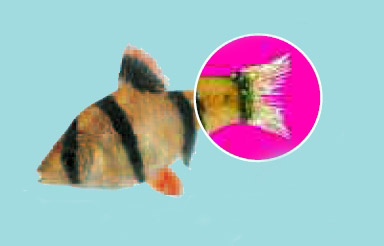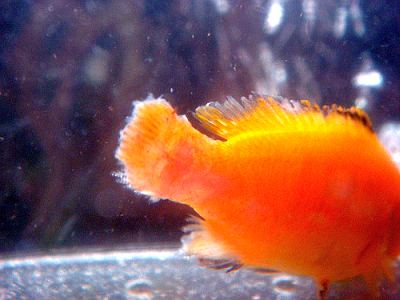| Fish Fin and Tail Rot |
 |
| Torn ragged fins, maybe stuck together |

Fin rot is often a symptom of disease and commonly plagues goldfish. It is not hard to treat fin rot and the outcome is usually positive. Fin rot is a symptom of a number of different diseases, but it can also be the result of an injury. It can be a primary or secondary infection. If it is primary it is a definite symptom of a specific bacterial invasion such as that by the mycobacterium that causes columnaris disease. Sometimes fin rot is the direct result of a secondary bacterial infection such as that which occurs when a goldfish is already weakened from another disease or following an injury.
| FIN ROT |
 |
| FIN ROT |
 |
Fin rot can be caused by a bacterial infection or a fungal infection. The bacterial infection results in a more ragged rotting while the fungal infection will rot the tail evenly and create a white edge.
When a whitish margin begins to appear at the edge of a torn or injured fin, a bacterial infection has probably taken hold. As the disease progresses, the fins rot away, eventually reaching the fin base and then into the body tissue itself. As diseased fin tissue dies, fungus often begins to grow on the dead areas. When that happens the white margin becomes inmistakable and may appear as a fuzzy, white, cottonlike edging.
The good news involving goldfish is that destroyed fin tissue can grow back if the damage does not reach the fin base. If , however the rot reaches the fin base, the goldfish will not be able to regenerate the damaged tissue. When the disease reaches the fin base , it may start to attack the goldfish body directly so the problem must be stopped before this happens.
 |
MARDEL TETRACYCLINE |
| Antibiotic that can be used to treat fin and tail rot, Popeye, secondary infections and gill disease.
Primarily effective against gram-negative pathogenic bacterial diseases of fish. Symptoms of clamped fins, general listlessness, not eating or other unusual behavior can be caused by internal infections and treatment with Tetracycline would be indicated. Tetracycline is recommended for treating Popeye, gill disease, fin and tail rot and other secondary infections.
Tetracycline is a broad-spectrum antibiotic that has been shown to be effective against a number of pathogenic bacteria associated with ornamental fish disease. Tetracycline may cause the water to turn red and a foam may collect on the water surface. It should not interfere with the biological filter. New activated carbon or charcoal and partial water changes after treatment will remove any remaining color as a result of the treatment. Available in tablet and powder form. Tablets and powder should be placed into the tank (not the filter). The tablets and powder dissolve and circulate through the water. For use in freshwater tanks only. |
Strong goldfish that are in a healthy environment can sustain injuries and never show signs of fin rot. It is never wrong, however, to assume that an injured fish will become a victim of fin rot. Therefore it is not wrong to treat an injured fish for fin rot before the rot actually occurs. Doing such preventive treatment can help to head off the bacterial invasion that often will occur at the site of the injury.
The treatment is to do a major water change, adding aquarium salt , and making sure that you are providing a healthy balanced diet with plenty of vitamins. Medications should be added as the main treatment. Antibiotics such as tetracycline, chloramphenicol, or furance can be used if after a few days of salt treatment there are no signs of recovery.
|

 Articles
Articles  Goldfish Disease
Goldfish Disease  Fin Rot
Fin Rot
 Articles
Articles  Goldfish Disease
Goldfish Disease  Fin Rot
Fin Rot